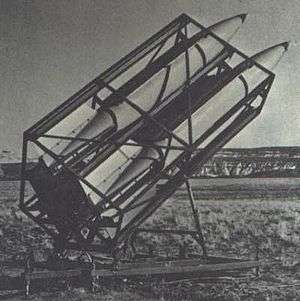MQR-16 Gunrunner
The MQR-16A Gunrunner was an unguided rocket developed by Atlantic Research during the 1960s. Designed with low cost as a priority, the MQR-16A was intended to act as a target drone for use in the development of man-portable surface-to-air missiles, and as a training target for the missile operators. Proving successful, the rocket served in the United States military until the 1980s.
| MQR-16 Gunrunner | |
|---|---|
 | |
| Type | Target drone |
| Place of origin | United States |
| Service history | |
| In service | 1969-1980s |
| Used by | United States Army, United States Navy |
| Production history | |
| Manufacturer | Atlantic Research |
| Specifications | |
| Mass | 290 pounds (130 kg) |
| Length | 16 feet (4.9 m) |
| Diameter | 20 inches (510 mm) |
| Engine | Booster, HVAR rocket; 5,800 lbf (26 kN) Sustainer, 10KS300 rocket, 290 lbf (1.3 kN) |
| Propellant | solid fuel |
Operational range | 3 miles (4.8 km) |
| Boost time | 10.86 sec |
| Maximum speed | 575 mph (925 km/h) |
Guidance system | None |
Launch platform | Triple launcher |
Design and development
Developed in the late 1960s, the Gunrunner was designed as an inexpensive aerial target, unguided and flying on a ballistic path, for use by the United States Army and United States Navy during the development and testing of the FIM-43 Redeye man-portable surface-to-air missile.[1]
The design and construction of the Gunrunner was kept as simple as possible, with the rocket's stabilizing fins using plywood in their construction, and the solid-fueled powerplant being that of the reliable and widely used High Velocity Aerial Rocket (HVAR).[2] The nose of the rocket was equipped with an infrared enhancer to allow for all-aspect target acquisition by the missile that was engaging the target.[2]
Operational history
Entering operational service in 1969, the Gunrunner was given the official designation of MQR-16A in 1971, and proved to be a success in service.[2] Used for training soldiers in the operation of both the Redeye and the MIM-72 Chaparral SAMs,[3] the missile was launched from a frame-type launcher that carried three missiles.[2] Remaining in service until the mid-1980s,[2] the Gunrunner was replaced in U.S. Army service by the MTR-15 BATS.[4]
References
Notes
- Morison 1975, p. 218.
- Parsch 2002
- Parsch 2009
- Goebel 2010
Bibliography
- Goebel, Greg (2010). "Modern US Target Drones". Unmanned Aerial Vehicles. vectorsite.net. Retrieved 2011-01-05.
- Morison, Samuel L. (1975). The Ships & Aircraft of the U.S. Fleet. Annapolis, MD: Naval Institute Press. ISBN 978-0-87021-639-8.
- Parsch, Andreas (2002). "Atlantic Research MQR-16 Gunrunner". Directory of U.S. Military Rockets and Missiles. designation-systems.net. Retrieved 2011-01-05.
- Parsch, Andreas (2009). "Current Designations of U.S. Unmanned Military Aerospace Vehicles". designation-systems.net. Retrieved 2011-01-05.